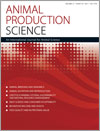
Animal Production Science
Volume 51 Number 10 2011
AN11011Blood mineral, trace-element and vitamin concentrations in Huacaya alpacas and Merino sheep grazing the same pasture
Many of the 100 000 alpacas in Australia are raised in areas where sheep and cattle are at risk from mineral and vitamin deficiencies. Little is known of the normal mineral and vitamin levels in blood of alpacas so our study was undertaken to compare these blood values with those for sheep. The findings are of value in identifying from blood tests alpacas that are at risk from mineral and vitamin deficiencies.
AN10019The β3-adrenergic agonist (BRL35135A) acutely increases oxygen consumption and plasma intermediate metabolites in sheep
An atypical adrenoreceptor subtype is thought to be involved in mediating some of the physiological effects of catecholamines, particularly in some adipose tissue sites of ruminants. Experiments were conducted to determine the metabolic and energetic responses to oral administration of a purported β3-agonist (BRL35135A) in ruminant lambs. BRL35135A was acutely active in sheep when given with feed and increased energy metabolism and fat mobilisation indicated that these effects were specific to the activation of purported β3-adrenergic receptors.
AN11028The role of tillage, fertiliser and forage species in sustaining dairying based on crops in southern Queensland 1. Winter-dominant forage systems
Forage crops are important for grazing animals in the subtropical cereal belt and are commonly established in a cultivated seedbed that has lain fallow over the previous season. The land growing winter crops is particularly vulnerable to erosion and fertility decline and we found that adopting zero-tillage practices and incorporating a lucerne phase in the cropping program could reduce these problems. The study was important in addressing farmer concerns on the practicality of zero-tillage under grazed conditions and the reliability of rain-grown lucerne.
AN11032The role of tillage, fertiliser and forage species in sustaining dairying based on crops in southern Queensland 2. Double-crop and summer sole-crop systems
While improvements can be made to winter cropping systems, fallowing makes inefficient use of summer rainfall and grazed winter crops leave little stubble for erosion control or the soil organic matter pool. We found that if a summer forage crop was grown, either following or instead of the winter crop, total forage yield could be substantially increased, the risk of erosion reduced and soil organic matter improved. In the subtropics, an emphasis on summer crops over winter crops is beneficial to both farm productivity and the soil-resource base.
AN11042Comparing somatic cell counts, production and milking durations of dairy cows when milked at two automatic cup-removal flow-rate thresholds
Increasing automated cup remover flow-rate settings for earlier cluster removal can decrease milking durations and reduce milking-associated costs if milk yields and udder health are unaffected. Automated cup remover flow-rate thresholds of 0.4 kg/min at peak lactation shortened per-cow milking durations by 11% without affecting milk quality, though milk, milksolids and protein yields were 1% less when compared to cows milked to 0.2 kg/min. Increasing automated cup remover flow-rate thresholds can decrease milking times without affecting udder health, but may impact overall production.
AN11006Survival of twin lambs is increased with shrub belts
Death of lambs in the days after birth is a significant cause of reproductive inefficiency with on average 20% of lambs dying. This study evaluated the use of shelter from wind to reduce lamb deaths, finding a 10% higher survival in twins sheltered by shrubs compared with hessian rows. Shrub belts, which force ewes to lamb in a sheltered environment, can increase survival of twins in some years.
AN10270The effect of annual shearing time on wool production by a spring-lambing Merino flock in south-eastern Australia
Time of shearing is an important management decision in sheep flocks, affecting many aspects of wool production and sheep health. A 5-year field study compared annual shearing in either December, March or May of Merino ewes and their progeny, March shearing produced the greatest total wool value over a sheep's lifetime. December shearing produced wool of only slightly lower total value, whereas May was a less preferable shearing time because it always produced wool of significantly lesser value.
AN10274Effect of lairage on lamb welfare and meat quality
Lairage is a commercial practice that allows animals to replenish muscle glycogen reducing dehydration and weight loss. Little research has been done to examine whether lairage influences meat quality and welfare. The study analyses the effects of lairage on stress and meat quality and its relationship with welfare in feedlot lambs. Results suggest that animals will be less stressed at slaughter with an overnight lairage. Optimal resting time will also depend on slaughter logistics. While stress can influence meat quality, these changes were small and within normal commercial range.
AN10267Constraints on establishing threshold levels for Warner–Bratzler shear-force values based on consumer sensory ratings for seven beef muscles
Cooked steaks from seven beef muscles were served to consumers to assess tenderness, juiciness, flavour, and overall like ratings and were compared to shear force values from the same steaks. Relationships between these were rather low possibly due to the narrow range of tenderness found in each muscle. Predicting consumer responses with shear force values is difficult when muscles are inherently tender.
AN11039Microscopic evidence for the uptake of orally given humic acids by the intestinal mucosa in piglets
The uptake of orally supplemented humic acids over the intestine is often controversially discussed. In this experiment humic acid particles were microscopically identified in the tissue of all intestinal segments, two gut and pelvis draining lymph nodes, trachea, and urinary bladder after being fed 1 g of humic acids per kg of bodyweight and day over a period of 14 days. Our results provide evidence that humic acids do penetrate the epithelial surface of the gastrointestinal tract and are most likely transported via lymph nodes to other mucosal organs.



